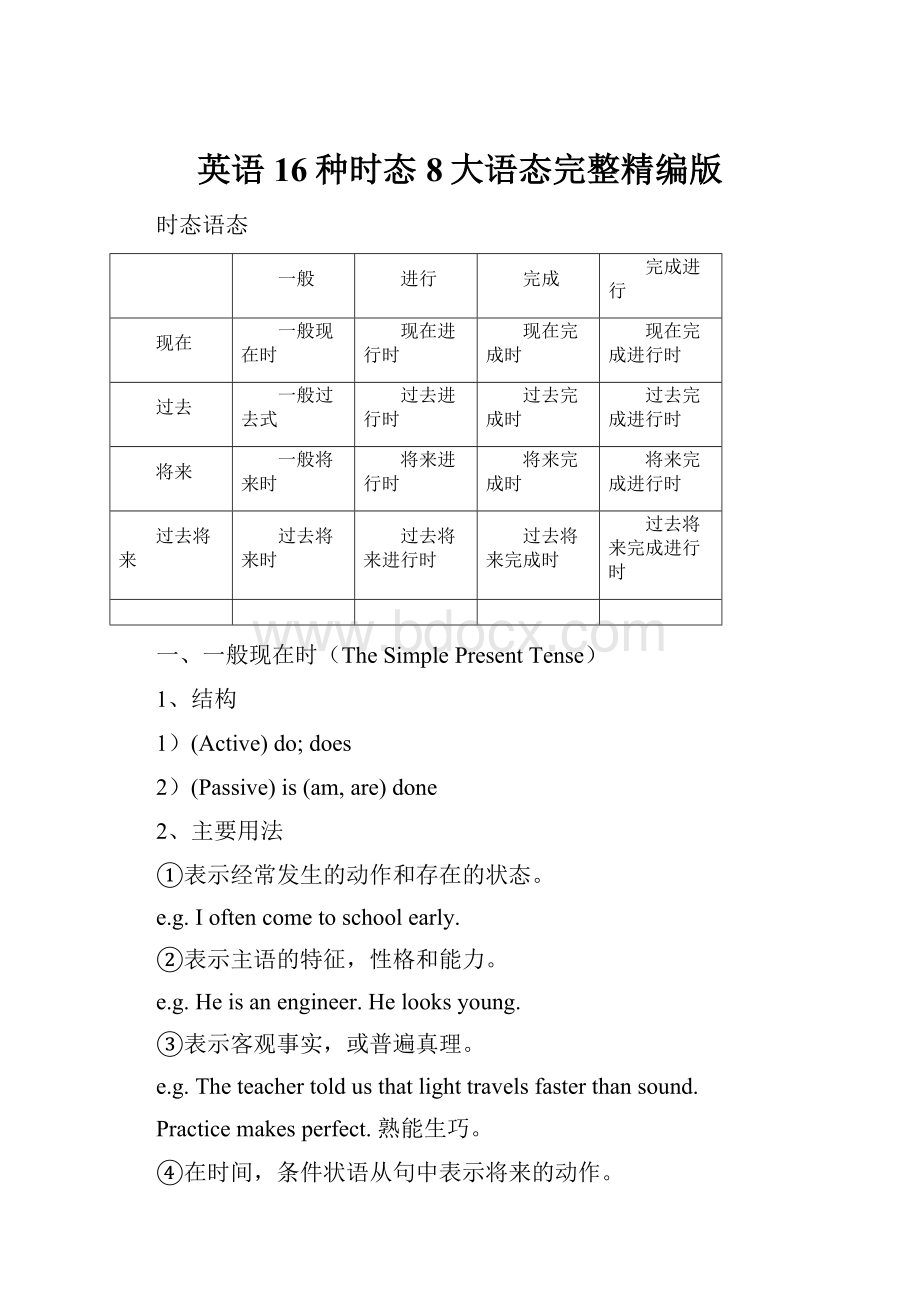英语16种时态8大语态完整精编版.docx
《英语16种时态8大语态完整精编版.docx》由会员分享,可在线阅读,更多相关《英语16种时态8大语态完整精编版.docx(10页珍藏版)》请在冰豆网上搜索。

英语16种时态8大语态完整精编版
时态语态
一般
进行
完成
完成进行
现在
一般现在时
现在进行时
现在完成时
现在完成进行时
过去
一般过去式
过去进行时
过去完成时
过去完成进行时
将来
一般将来时
将来进行时
将来完成时
将来完成进行时
过去将来
过去将来时
过去将来进行时
过去将来完成时
过去将来完成进行时
一、一般现在时(TheSimplePresentTense)
1、结构
1)(Active)do;does
2)(Passive)is(am,are)done
2、主要用法
①表示经常发生的动作和存在的状态。
e.g.Ioftencometoschoolearly.
②表示主语的特征,性格和能力。
e.g.Heisanengineer.Helooksyoung.
③表示客观事实,或普遍真理。
e.g.Theteachertoldusthatlighttravelsfasterthansound.
Practicemakesperfect.熟能生巧。
④在时间,条件状语从句中表示将来的动作。
e.g.I’lltellhimaboutitwhenhereturnshome.
⑤表示按时刻表计划或安排好的动作。
(只限于表示起始或移动意义的动词。
begin,come,leave,start,arrive,go,etc.)
e.g.Iwillfindoutwhenthetrainleaves.
TheplaneforSanFranciscotakesoffatthreep.m..
3、与一般现在时连用的时间状语:
everyday,onceaweek,twiceaweek,always,usually,often,sometimes,seldom,neveretc.
e.g.Igotothecinemaonceaweek.
e.g.Sometimesweworkuntiltwelveo’clock.
4、主动变被动
1)Doyouoftencleanyourroom?
Isyourroomoftencleaned?
2)PeoplespeakEnglishinmanycountries.
Englishisspokeninmanycountries.
二、一般过去时(TheSimplePastTense)
1、结构
1)(Active)did
2)(Passive)was/weredone
2、主要用法
①表示过去的动作或状态。
②表示过去一段时间内经常或反复发生的动作,也可用:
usedto+v.或would+v.
e.g.Heusedtohavetwobrothers.
e.g.Whenhewasfree,hewouldgoandhelpothers.
③在条件和时间状语从句中,表示过去将来的动作。
e.g.ItoldhimIwouldlendhimmybikeifMr.Smithreturnedittomethenextday.
3、一般过去时常与这些时间状语连用:
yesterday,beforeliberation,in1960,twoyearsago,lastmonth,inthepast,theotherday,etc.
e.g.Ihappenedtomeethiminthestreettheotherday.
4、主动变被动
1)Thetigerinthezoofrightenedthelittlegirl.
Thelittlegirlwasfrightenedbythetigerinthezoo.
2)Theygavehimamedalforhiswonderfulwork.
Hewasgivenamedalforhiswonderfulwork.
三、一般将来时(TheSimpleFutureTense)
1、结构
1)(Active)willdo/shall
2)(Passive)will/shallbedone
2、主要用法
①表示将来的动作和状态。
e.g.ThefarmerswillbegintopickapplesnextMonday.
e.g.Hewillcometoseeustomorrow.
②表示将来的其他用法:
<1>begoingto+v.表示打算、准备做的事,或根据迹象表明即将发生或肯定要发生的事。
e.g.Howareyougoingtospendyourholidays?
It’sgoingtosnow.
There’sgoingtobealotoftroubleaboutthis.
<2>beaboutto+v.表示即刻要发生的动作。
*beaboutto…when…
e.g.Iwasabouttogoswimmingwhenluckilyourguidesawmeandshoutedatme“stop!
”
<3>beto+v.表示安排或计划好的动作。
e.g.Anewhospitalistobebuiltinourdistrict.
Wearetomeetattheschoolgateatfiveo’clockthisafternoon.
<4>现在进行时表示按计划安排要发生的事。
限于某些瞬时动词,如:
leave,go,come,arrive,start,etc.
e.g.Myuncleisarrivingat3:
30p.m.tomorrow.
3、一般将来时常与这些时间状语连用:
tomorrow,nextweek,inamoment,inthefuture,etc.
e.g.---Howsoonwillhebeback?
---Hewillbebackintwoweeks.
4、主动变被动
1)Peoplewilllaughatyouifyouwearthatdress.
Youwillbelaughedatifyouwearthatdress.
2)Theywon'tholdthemeetinguntilnextFriday.
Themeetingwon’tbehelduntilnextFriday.
3)Thedoctorwillaskthepatientsomequestionsbeforehegiveshermedicine.
Thepatientwillbeaskedsomequestionsbeforesheisgiventhemedicine.
四、过去将来时(ThePastFutureTense)
1、结构
1)(Active)woulddo
2)(Passive)wouldbedone
2、用法说明
不能独立使用,通常用在宾语从句中,表示从过去某一点看,在将来发生的动作或存在的状态。
e.g.HetoldmethathewouldgotoBeijingthenextmonth.
AtthattimeIdidnotknowifhewouldbeabletofinishtheworkontime.
五、现在进行时(ThePresentContinuousTense)
1、结构
1)(Active)is/am/aredoing
2)(Passive)is/am/arebeingdone
2、主要用法
①表示说话的时刻正在进行的动作。
e.g.---Whataretheydoing?
---Theyareplayinginthegarden.
②表示现阶段正在进行的动作,尽管此刻这个动作可能并不在进行。
e.g.Themanageristypinghislettersthesedays.
Heisateacherofphysics,butheisnowteachingmath.
Sheisworkinginabookshop.他目前在一家书店工作。
③现在进行时用来表示将来(Futureuse),即表示按计划或安排在最近将要进行的动作。
这种用法仅限于少数表示动作的动词,如arrive,come,go,have,leave,start,stay等。
e.g.HowlongareyoustayinginXi'an?
你将在西安呆多久?
We'rehavingaholidaynextMonday.我们将在下星期一放假。
④现在进行时态如果同副词always,constantly,continually等连用,常带有或褒或贬的语气。
e.g.HeisalwayshelpingmewithmyEnglish.(称赞)
Sheisconstantlycominglate.她老迟到。
(不满)
3、注意*下列动词不能用进行时态:
感官类:
see,hear,smell,taste,feel,notice,look,seem,appear等
感觉类:
hate,love,fear,like,want,wish,prefer,refuse,forgive等
存在类:
be,exist,remain,stay,obtain
占有从属类:
have,possess,own,contain,belong,consistof等
认知类:
understand,know,believe,think,doubt,forget,remember等
e.g.Iunderstandwhatyoumean.
Iloveourgreatmotherland.
I(can)smellsomethingburning.
Theflowersmellssweet.
六、过去进行时(ThePastContinuousTense)
1、结构
1)(Active)was/weredoing
2)(Passive)was/werebeingdone
2、主要用法
①表示过去某一时刻正在进行的动作。
e.g.Whatwereyoudoingthistimeyesterday?
Iwaswritingaletterwhenshecamein.
②表示过去某阶段在进行的暂时性习惯动作。
e.g.Heisadoctor,butatthattimehewasworkinginalaboratory.
③表示过去将要发生的动作,但只限于一些表示起始和移动意义的动词。
e.g.Ihadthoughtthathewascomingtoseemethenextday,buthedidn’t.
WhenIgotthere,theywerepreparingfortheirtrip,astheywereleavingthatafternoon.
④表示刚才的情况。
e.g.Iwasaskingwhatyouthoughtofit.
e.g.--Canyougivemetherightanswer?
--Sorry,Iwasn’tlistening.Wouldyoupleaserepeatthatquestion?
⑤描写故事的背景。
e.g.Oneday,wewerewalkingalongaroad,whichwentaroundthefootofthehill.Suddenly……
七、现在完成时(ThePresentPerfectTense)
1、结构
1)(Active)have/hasdone
2)(Passive)have/hasbeendone
2、主要用法
①表示发生在过去的动作到现在为止已经完成,或刚刚完成。
e.g.Hehasfinishedreadingthebooktoday.
TherehavebeengreatchangesinBeijinginthepasttwentyyears.
②表示发生在过去的动作一直延续到现在。
e.g.Theconferencehaslastedforfivedays.
Wehaveknowneachothersincewewerechildren.
③表示动作在过去完成,构成主语的经历。
e.g.IhavebeentotheGreatWallthreetimes.
ThisisthefourthtimethatIhaveseenthefilm.Ilikeitverymuch.
④表示动作发生在过去,但对现在的情况产生影响。
e.g.Thankyou.Ihavehadmysupper.
I’msorryIcan’tgowithyou.Ihaveseenthefilm.
⑤在时间和条件状语从句中,表示将来完成的动作。
(表示这一动作先于另一动作。
)
e.g.IwillgoandseetheexhibitionassoonasIhavegottherecorderrepaired.
IwilllendthebooktoyouwhenIhavefinishedreadingit.
*注意事项:
瞬间动作的肯定式一般不可与表示一段时间的状语一起用于现在完成时。
瞬间动词的否定式可以与表示一段时间状语一起用于现在完成时。
e.g.Hehascomeherefortwodays.×
Hehasbeenherefortwodays.√
Itistwodayssincehecamehere.√
Hecameheretwodaysago.√
Hehasnotcomeherefortwodays.√
3)现在完成时常与这些时间状语连用:
already,not…yet,threetimes,lately,just,Itisthefirst/second/thirdtimethat…before,inrecentyears,since…,fortwoyears,in/duringthepastfewyears,sofar,upto/tillnow
e.g.Inthepasttwentyyears,greatchangeshavetakenplaceinChina.
八、过去完成时(ThePastPerfectTense)
1、结构
1)(Active)haddone
2)(Passive)hadbeendone
2、主要用法
表示过去某个时间以前已经完成的动作或存在的状态。
e.g.HehadalreadyleftwhenIgotthere.
Theyshowedusthemachinewhichtheyhadproduced.
*若句子中含有before,after,assoonas,until等连词引导的时间状语从句,通常可用一般过去时代替过去完成时。
e.g.Afterhefinishedthetask,heleftforthenexttown.
⏹Itisthefirst/second…timethat从句。
的从句中一般用现在完成时。
⏹另外:
“Itis/hasbeen+一段时间+since…did……”since从句动词通常用过去时,主句用完成时。
⏹有些瞬间性动词在完成时态的肯定句不能和表示一段时间的时间状语连用。
要连用时须用状态动词。
⏹成对的词有:
become/be;die/bedead;leave/beaway;jointhearmy/servethearmy…
九、现在完成进行时(ThePresentPerfectcontinuousTense)
1、结构
1)(Active)have/hasbeendoing
2)(Passive)
2、主要用法
表示动作从过去某一时刻开始,一直延续到现在,现在这个动作可能刚刚终止,也可能仍然在进行着。
e.g.Wehavebeenlisteningtotheradioforanhour.
--Youlooktired,don’tyou?
--Yes,Ihavebeenpaintingtheroomallday.
十、过去完成进行时(ThePastPerfectContinuousTense)
1、结构
1)(Active)hadbeendoing
2)(Passive)
2、主要用法
表示过去某一时间以前一直在进行的动作。
e.g.Ithadbeenrainingfortwodays.Thefieldswereallunderwater.
Atlasttheygotthetelegramtheyhadbeenexpecting.
十一、时态呼应
主句
从句
例句
现在或将来时
任何时态
HeknowswhatIsaid.
LiLeitellsmethathe’llcome.
过去时(表示主从句的动作同时发生)
一般过去或过去进行
Ididn’tknowyouwerestudyinghere.
过去时(表示从句动作发生在主句动作之前)
过去完成时
Hesaidhehadlosthiskey.
过去时(表示从句动作发生在主句动作之后)
过去将来时
Hetoldmehewouldgototheconcert.
过去时(从句表达的是客观真理)
现在时
Theteachersaidthatthesunrisesintheeast.
*当从句含有某一具体的过去时间状语时,其谓语不用过去完成时。
e.g.Hetoldmehewasbornin1954.
Themansaidthathejoinedthearmyintheyear1964.
●主动变被动
1)Ihavetoldhimthathedidn'tsatisfyhisexaminer.
Hewastoldthathisexaminerdidn’tsatisfiedbyhim.
2)Theyhavefoundwaystomakewastewaterclean.
Thewaystomakewastewatercleanwerefoundbythem.